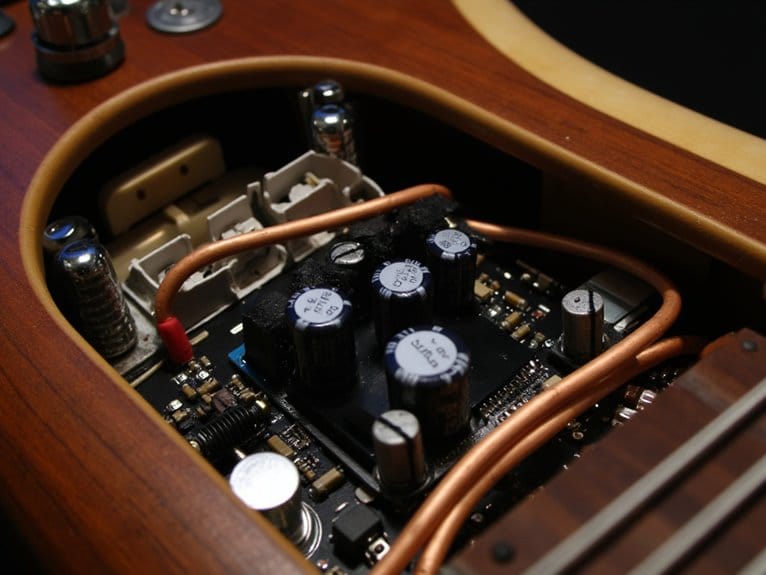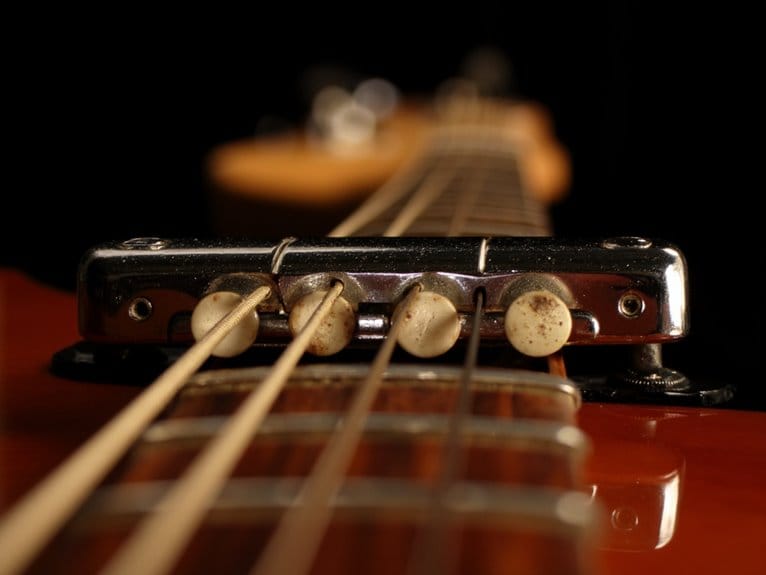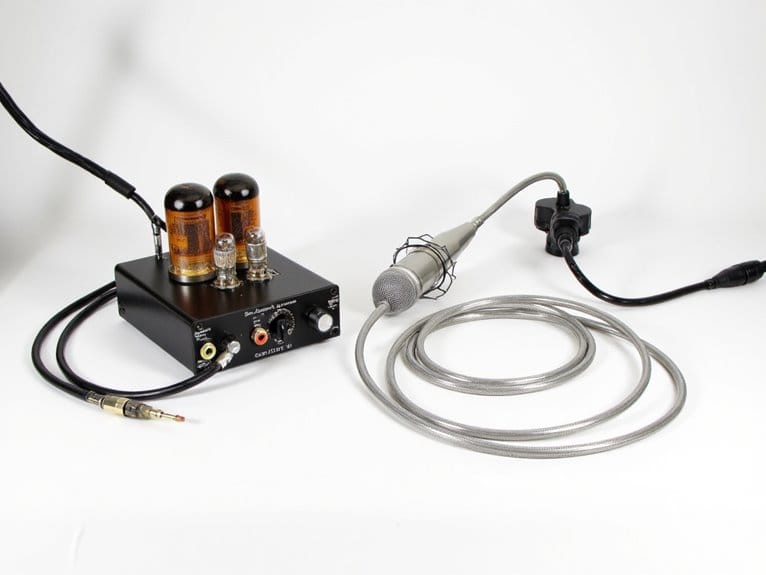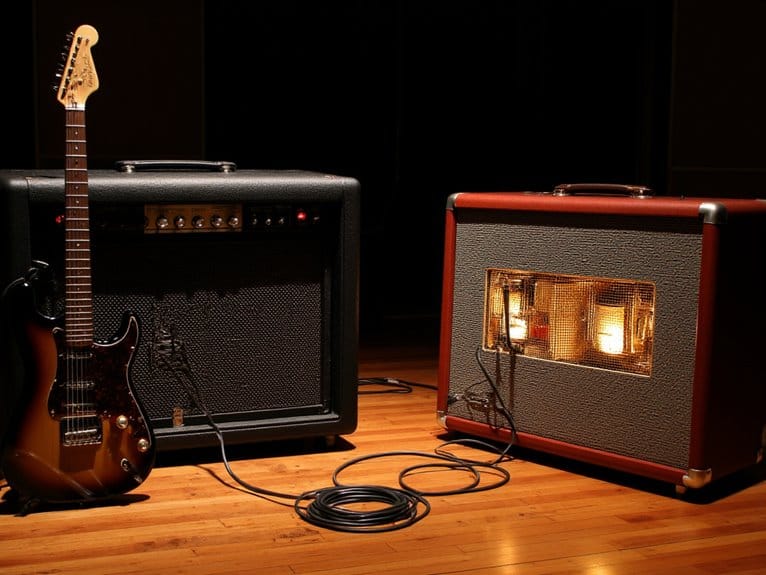Understanding Bass Guitar Electronics and Preamps
Your bass guitar’s electronics work as a signal chain, starting with pickups that convert string vibrations into electrical signals, flowing through volume and tone potentiometers that shape frequency response, then reaching the output jack. Single-coil pickups deliver bright clarity, while humbuckers provide warmer midrange power, and you’ll find active preamps offer precise EQ control with battery power, versus passive systems that emphasize reliability and simplicity. Understanding these components reveals your instrument’s full potential.
We are supported by our audience. When you purchase through links on our site, we may earn an affiliate commission, at no extra cost for you. Learn more.
Notable Insights
- Pickups convert string vibrations to electrical signals, with single-coils offering brightness while humbuckers provide warmer, powerful midrange tones.
- Active preamps require batteries but offer precise onboard EQ control and superior signal integrity over passive systems.
- Tone pots combined with capacitors create low-pass filters, where larger capacitor values produce darker tones than smaller values.
- Wiring configurations significantly impact sound: parallel wiring maintains brightness while series wiring increases bass response and thickness.
- Proper shielding with conductive paint or foil prevents noise issues, and quality components ensure better tone and long-term reliability.
Essential Electronic Components and Their Functions
When you’re looking under the hood of your bass guitar’s electronics, you’ll find a surprisingly simple yet sophisticated collection of components that work together to transform string vibrations into the powerful, rich tones that define your sound.
Pickups serve as the foundation, converting mechanical string movement into electrical signals that flow through your instrument’s circuitry.
At the heart of every bass guitar, pickups transform the physical energy of vibrating strings into the electrical signals that become your music.
Potentiometer functions include volume control using audio-taper pots for natural response curves, while tone pots work with capacitors to create low-pass filters that shape your frequency response.
Capacitor values, measured in microfarads, determine how much high-end gets rolled off—larger values create darker tones, smaller ones maintain brightness.
Finally, your output jack and internal wiring complete the signal chain, delivering your crafted tone to your amplifier. For enhanced sound processing, many bassists utilize external preamps with 3-band EQ capabilities to further shape their tone before reaching the main amplifier stage. The output jack correctly serves as the exit point for your bass signal, not an input as commonly misunderstood. The pickup placement significantly affects your tone characteristics, with neck-positioned pickups producing warmer sounds compared to bridge-positioned pickups that deliver brighter, more defined tones. Understanding the difference between passive vs. active pickup systems helps you choose the right setup for your playing style, as passive pickups provide traditional warm tones without battery requirements while active systems deliver higher output with built-in preamps. External bass preamps offer DI capabilities that allow direct connection to live sound systems and recording equipment, eliminating the need for additional hardware during performances.
Pickup Types and Tonal Characteristics
Most bassists eventually discover that the type of pickup living inside their instrument fundamentally shapes their sound more than any other single component.
I’ve spent countless hours swapping pickups to understand exactly how each design affects tone, output, and playing dynamics.
Single-coil pickups deliver bright, articulate clarity that’s perfect for funk and jazz, though they’ll pick up electromagnetic interference from stage lighting.
Split-coil P-style pickups offer that warm, punchy Motown thump while canceling hum through their dual-coil design. Many PJ pickup configurations combine the classic P-bass split-coil with a bridge Jazz pickup, providing expanded tonal versatility for players exploring different musical styles.
Humbuckers provide aggressive midrange power for rock and metal, sacrificing some brightness for noise-free operation. The technology behind humbuckers traces back to Electro-Voice in 1934, though Gibson popularized them for bass applications decades later.
The magnet material inside your pickups also affects your tone significantly, with Alnico magnets delivering warm character while ceramic magnets provide higher output levels.
Just as pickup quality matters, proper tuning stability requires gear ratios of 19:1 or higher to maintain consistent pitch during performance.
Your pickup selection directly impacts your tonal versatility, so understanding these fundamental differences helps you choose the right tool for each musical situation.
Wiring Configurations and Signal Path
Although pickup selection determines your fundamental tone, the wiring configuration that connects those pickups creates the actual signal path that shapes how your bass communicates with the outside world.
I’ve learned through years of rewiring instruments that understanding this electrical roadmap is essential for any serious bassist. Your signal begins at the pickups, travels through volume and tone potentiometers, passes through switches that control signal routing, and finally reaches the output jack.
Different wiring techniques dramatically alter your sound—parallel configurations maintain brightness and output levels, while series wiring increases bass response and thickness.
The wiring path you choose fundamentally shapes your bass’s voice—parallel wiring preserves clarity while series configuration delivers deeper, thicker tones.
Advanced signal routing options include coil splitting for humbuckers, phase switches, and blend controls that provide extensive tonal variety for complex musical situations.
Active Vs Passive Preamp Systems
Once your signal routing is properly configured, the type of preamp system in your bass—active or passive—becomes the most influential factor in determining your instrument’s tonal capabilities, output characteristics, and overall sonic personality.
Active systems deliver remarkable versatility through onboard EQ controls, allowing you to boost and cut frequencies with precision. However, they require 9V battery power, which means you’ll need to monitor battery life to avoid mid-performance failures.
Passive advantages include simplicity and reliability—no batteries mean no power-related concerns during gigs. Quality cables with oxygen-free copper conductors become especially important for passive systems to maintain signal clarity over longer runs.
- Active tone shaping occurs before your amplifier, maintaining superior signal integrity.
- Battery-powered circuits produce higher output levels and cleaner signals over long cable runs.
- Passive setups offer vintage character that some players find more musical than sterile active circuits.
- Switchable systems provide both worlds, letting you toggle between active and passive modes.
Your choice depends on balancing tonal flexibility against reliability requirements. Some modern bass guitars feature active/passive switching with LED battery indicators to prevent unexpected power loss during performances. Active 4-band EQ systems allow precise sound control and facilitate adaptation across diverse musical genres from rock to jazz.
Installation Tips and Common Modifications
When you’re ready to upgrade your bass electronics, proper preparation becomes the foundation that separates a professional installation from a frustrating nightmare filled with stripped screws and damaged components.
Cavity preparation involves removing existing hardware carefully, checking for adequate shielding with conductive paint or foil, and taping component areas before any drilling to prevent sawdust contamination.
Smart wiring techniques include matching preamp pin headers with corresponding wire colors to reduce soldering errors, using pin headers for plug-in connections, and securing batteries with double-sided tape to avoid wire crimping.
Consider stacked potentiometers when space is limited, and always test your preamp temporarily before final assembly, keeping in mind that unshielded testing may introduce extra hum or noise that disappears once properly installed.
Frequently Asked Questions
What Causes Electromagnetic Interference and How Do I Shield Against It Effectively?
You’ll encounter electromagnetic interference from electronic devices, power lines, and radio frequencies disrupting your equipment. Effective signal shielding uses metal enclosures, grounded cables, and EMI filters for noise reduction and protection.
Do Expensive Cables Really Make a Noticeable Difference in Bass Tone?
Expensive cables don’t make noticeable differences in bass tone despite premium cable materials claims. You’re paying for marketing, not improved sound clarity. Focus on low capacitance specs rather than price for actual tonal benefits.
On a final note
You’ve now got the foundation to understand your bass’s electronic heart, from the magnetic pickups that capture string vibrations to the preamp circuits that shape your tone before it hits the amp. Whether you’re running passive pickups with simple volume and tone controls, or active electronics with sophisticated EQ sections, you’ll make more informed decisions about modifications, troubleshooting, and gear purchases that’ll serve your musical goals.







